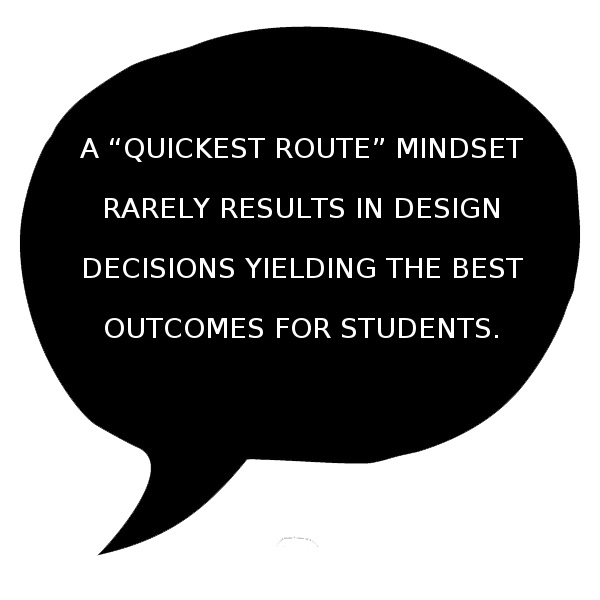Author and Editor: Dr. Kelvin Thompson
Dear ADDIE:
As instructional designers we are sometimes frustrated to see our faculty use publisher materials as the basis for their online courses. While it is possible to integrate these kinds of materials meaningfully, that is often not what we see happening. It is so tempting for instructors to simply add a link to a publisher’s website and be done with it. Online students can become confused or lost since they must leave their course for an external website. Once they are away from the course browsing around the internet, you can lose them forever! Additionally, instructors can become frustrated because their grades may now appear on the publisher’s website rather than in their own online course gradebook. Copying grades back into the course website is twice the work! (Sometimes it is more work for us as instructional designers too, because we end up helping with the copying!)
We don’t encourage relying on publisher materials in our faculty training, and we can’t stop faculty from making these decisions after the training.
What can we do?
Signed,
Pondering Publisher-Provided Problems
Dear Pondering:
As you’ve suggested, publisher-provided materials are not the problem per se. You’ve rightly expressed concern for what, in our opinion, is the central issue: the quality of the online student learning experience. Any number of factors may impact this student experience positively or negatively. If we had to boil down to one idea the single biggest contributor to positive student experience, though, we would say “intentional design.”
Deliberate, thoughtful decisions about learning outcomes, content selection, student learning activities/assignments, assessments of learning, interaction opportunities, and practical usability are likely the best way to bring about consistently positive student experiences that result in student learning. This is true of individual online courses and entire programs offered by institutions.
Some faculty, expert in their subject areas but not equipped for the systematic design of instruction, may be tempted to assemble courses from components ready at-hand with the least amount of time investment necessary. One can hardly fault faculty for wanting to be time efficient given the myriad demands competing for their attention! However, a “quickest route” mindset rarely results in design decisions yielding the best outcomes for students.
As you’ve noted, faculty preparation for teaching online (i.e., faculty development/training) is the starting point for this kind of intentional design by online instructors. However, nurturing intentional design as an on-going, iterative process may be the best long-term strategy. That is, course design is not a one-time, set-it-and-forget-it kind of thing. Common methods for facilitating this kind of iterative decision-making, depending upon your particular institutional context may include: faculty learning communities, peer mentors, or consultations with an instructional designer.
One sometimes overlooked resource useful in each of these approaches is the course quality rubric. As the Open SUNY Center for Online Teaching Excellence (COTE) has noted regarding their open-licensed rubric (OSCQR):
The rubric can be used formatively with… online faculty to help guide, inform and influence the design of their new [or mature] online courses. It is non-evaluative: Conceptually the rubric and process approach course review and refresh as a professional development exercise, to guide faculty in their understanding of improving course design from an effective practices perspective, rather than as a course evaluation, or quality assurance procedure. It prioritizes changes. (Read more.)
If your institution has not already adopted a course quality rubric, the TOPkit “Checklists & Rubrics” section provides a collection of annotated links to many online course standards, rubrics, and checklists drawn from a variety of contexts. Such resources can be helpful indeed if approached as guides in the iterative course design process.
It is our hope that placing a systemic emphasis on intentional design will negate the ill effects of over-reliance on publisher-provided materials and other less mindful decisions.
What thoughts do others have? Please share your thoughts with our TOPkit community on LinkedIn!
Until next month,
